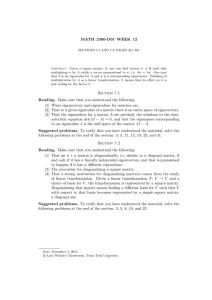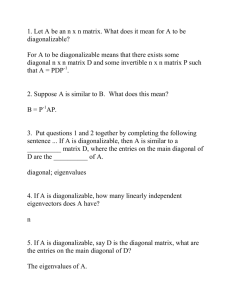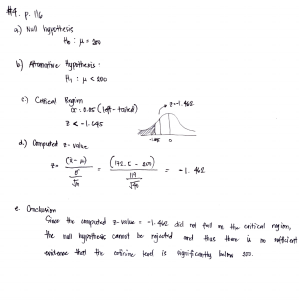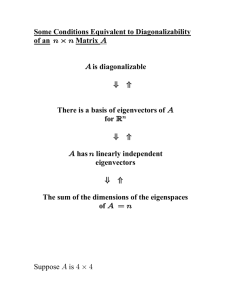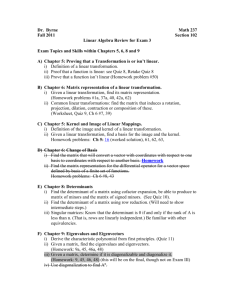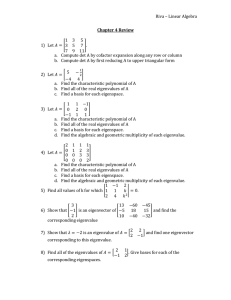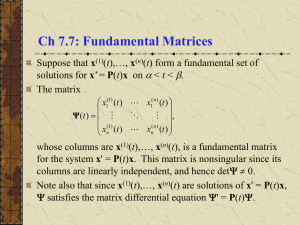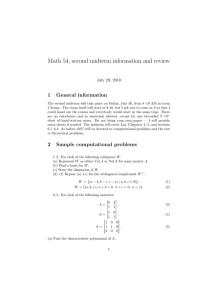Linear Algebra Final Exam
advertisement
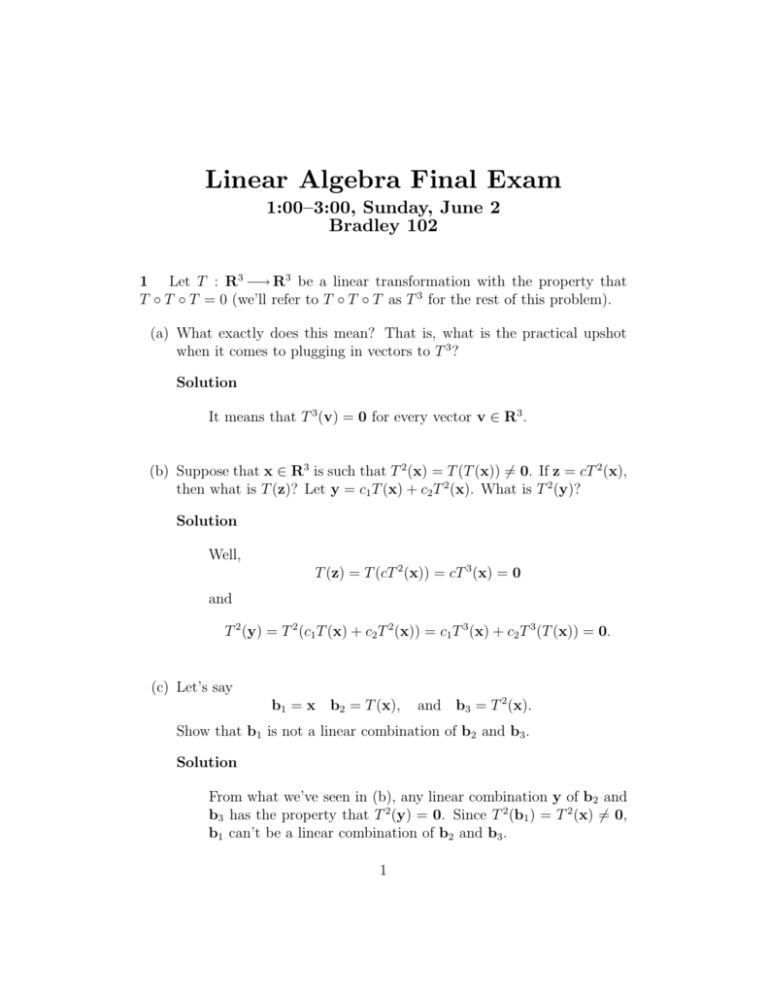
Linear Algebra Final Exam
1:00–3:00, Sunday, June 2
Bradley 102
1 Let T : R3 −→ R3 be a linear transformation with the property that
T ◦ T ◦ T = 0 (we’ll refer to T ◦ T ◦ T as T 3 for the rest of this problem).
(a) What exactly does this mean? That is, what is the practical upshot
when it comes to plugging in vectors to T 3 ?
Solution
It means that T 3 (v) = 0 for every vector v ∈ R3 .
(b) Suppose that x ∈ R3 is such that T 2 (x) = T (T (x)) 6= 0. If z = cT 2 (x),
then what is T (z)? Let y = c1 T (x) + c2 T 2 (x). What is T 2 (y)?
Solution
Well,
T (z) = T (cT 2 (x)) = cT 3 (x) = 0
and
T 2 (y) = T 2 (c1 T (x) + c2 T 2 (x)) = c1 T 3 (x) + c2 T 3 (T (x)) = 0.
(c) Let’s say
b1 = x b2 = T (x),
and b3 = T 2 (x).
Show that b1 is not a linear combination of b2 and b3 .
Solution
From what we’ve seen in (b), any linear combination y of b2 and
b3 has the property that T 2 (y) = 0. Since T 2 (b1 ) = T 2 (x) 6= 0,
b1 can’t be a linear combination of b2 and b3 .
1
(d) Explain why the set B = {b1 , b2 , b3 } is a basis for R3 . (Hint: Some
of the work you’ve already done might help. )
Solution
We know that T (b2 ) = T 2 (x) 6= 0 and T (b3 ) = 0, so b2 is not
a multiple of b1 . And we showed in (c) that b1 is not a linear
combination of b2 and b3 , so the whole set must be linearly independent. Since we are working in R3 , any linearly independent
set of 3 vectors is a basis.
(e) Find the B-matrix for the linear transformation T . (This can be done
with very little work).
Solution
Since
T (b1 ) = b2 ,
T (b2 ) = b3
the matrix must be
2
Let
and T (b3 ) = 0,
0 0 0
1 0 0.
0 1 0
3 0 0
A = 0 4 1.
0 2 5
(a) Find the eigenvalues of A. (Hint: λ2 − 9λ + 18 = (λ − 3)(λ − 6) )
Solution
The characteristic polynomial is
det(A−λI) = (3−λ)((4−λ)(5−λ)−2) = (3−λ)(λ2 −9λ+18) = (3−λ)(λ−3)(λ−6).
Therefore the eigenvalues of A are 3 and 6.
2
(b) Find bases for the eigenspaces of A.
Solution
First let’s handle λ = 3. We need to solve (A − 3I)v = 0 by
reducing the matrix
0 0 0
0 1 1
A − 3I = 0 1 1 ∼ 0 0 0 .
0 2 2
0 0 0
This shows that the eigenspace for λ = 3 is
1
0 )
span 0 , 1 .
0
−1
(
For λ = 6, we row reduce
−3 0
0
1 0 0
A − 6I = 0 −2 1 ∼ 0 2 −1 .
0
2 −1
0 0 0
This shows that the eigenspace for λ = 3 is
(
0 )
span 21 .
1
(c) Write down an invertible matrix P and a diagonal matrix D such that
A = P DP −1 . Briefly explain yourself.
Solution
We have a basis
0 )
0
1
1
B = 0, 1 , 2
−1
0
1
(
3
for R3 consisting of eigenvectors for A. The matrix P is the change
of coordinates from B to the standard basis, and D is the diagonal
matrix with the eigenvalues on the diagonal. Thus if
1 0
P =
1
0
0 −1
0
1
2
1
3 0 0
and D =
0 3 0
0 0 6
then A = P DP −1 .
3
(a) Suppose T : V −→ V is a linear transformation, and that B = {b1 , b2 , b3 }
is a basis for V . If the B-matrix for T is
2 3 5
A = 7 11 13 ,
17 19 23
then what is T (2b1 + 4b3 )?
Solution
Calculate T (2b1 + 4b3 ) = 16b1 + 58b2 + 110b3 .
(b) Explain why the image (range) of a linear transformation T : V −→ W
is a subspace of W .
Solution
The image of T is the set Im(T ) = {T (v) | v ∈ V }. If x, y ∈ Im(T )
and c, d ∈ R, then x = T (v) for some v ∈ V and y = T (u) for
some u ∈ V . Then
cx + dy = cT (v) + dT (u) = T (cv + du).
Since V is a vector space, cv + du ∈ V , so cx + dy ∈ Im(T ).
4
(c) Is the matrix
diagonalizable? Explain.
1 2 3
A=
0 5 8
0 0 13
Solution
Yes. It is upper triangular, so we can get the eigenvalues from
the diagonal. Since there are three distinct eigenvalues and we’re
working with R3 , there will be a basis for R3 consisting of eigenvectors of A, which is the same as saying that A is diagonalizable.
(d) If the column space of a 8 × 4 matrix A is 3-dimensional, then what is
the dimension of the null space?
Solution
There are 3 pivot columns, leaving 1 nonpivot column, so the
dimension of Nul(A) is 1.
4
Consider the matrix
1 1 2 2
A = 2 2 5 5
0 0 3 3
(a) Find a basis (which I will refer to as B) for Nul(A).
Solution
First row reduce A:
1 1 0 0
1 1 2 2
1 1 2 2
A = 2 2 5 5 ∼ 0 0 1 1 ∼ 0 0 1 1
.
0 0 0 0
0 0 3 3
0 0 3 3
5
We see from this that Nul(A) has a basis
1
−1
b1 =
,
0
0
0
0
b2 =
.
1
−1
(b) Let V = Nul(A). Then we can define a linear transformation
T : V −→ R3
by T (v) = Av. Write down the matrix for T in terms of the basis B of
V and the standard basis E = {e1 , e2 , e3 } of R3 .
Solution
The matrix we want will be M = [T (b1 ), T (b2 )]. Since both b1
and b2 are in Nul(A), T (b1 ) = T (b2 ) = 0, so the matrix is
0 0
M = 0 0.
0 0
6
